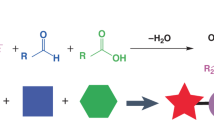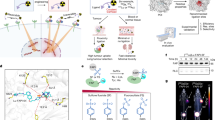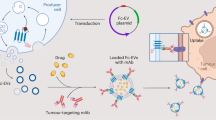Abstract
Methods to attach polypeptides to lipid bilayers are often indirect and ineffective, and can represent a substantial bottleneck in the formation of functionalized lipid-based materials. Although the polyhistidine tag (his-tag) has been transformative in its simplicity and efficacy in binding to immobilized metals, the successful application of this approach has been challenging in physiological settings. Here we show that lipid bilayers containing porphyrin–phospholipid conjugates that are chelated with cobalt, but not with other metals, can effectively capture his-tagged proteins and peptides. The binding follows a Co(II) to Co(III) transition and occurs within the sheltered hydrophobic bilayer, resulting in an essentially irreversible attachment in serum or in a million fold excess of competing imidazole. Using this approach we anchored homing peptides into the bilayer of preformed and cargo-loaded liposomes to enable tumour targeting without disrupting the bilayer integrity. As a further demonstration, a synthetic protein fragment derived from the human immunodeficiency virus was bound to immunogenic liposomes for potent antibody generation for an otherwise non-antigenic peptide.
This is a preview of subscription content, access via your institution
Access options
Subscribe to this journal
Receive 12 print issues and online access
$259.00 per year
only $21.58 per issue
Buy this article
- Purchase on Springer Link
- Instant access to full article PDF
Prices may be subject to local taxes which are calculated during checkout






Similar content being viewed by others
References
Brannon-Peppas, L. & Blanchette, J. O. Nanoparticle and targeted systems for cancer therapy. Adv. Drug Deliv. Rev. 206–212 (2012).
Purcell, A. W., McCluskey, J. & Rossjohn, J. More than one reason to rethink the use of peptides in vaccine design. Nature Rev. Drug Discov. 6, 404–414 (2007).
Canalle, L. A., Löwik, D. W. P. M. & van Hest, J. C. M. Polypeptide-polymer bioconjugates. Chem. Soc. Rev. 39, 329–353 (2010).
Nobs, L., Buchegger, F., Gurny, R. & Allémann, E. Current methods for attaching targeting ligands to liposomes and nanoparticles. J. Pharm. Sci. 93, 1980–1992 (2004).
Algar, W. R. et al. The controlled display of biomolecules on nanoparticles: a challenge suited to bioorthogonal chemistry. Bioconjug. Chem. 22, 825–858 (2011).
Sapra, P. & Allen, T. M. Ligand-targeted liposomal anticancer drugs. Prog. Lipid Res. 42, 439–462 (2003).
Kirpotin, D. et al. Sterically stabilized anti-HER2 immunoliposomes: design and targeting to human breast cancer cells in vitro. Biochemistry 36, 66–75 (1997).
Yang, T. et al. Preparation and evaluation of paclitaxel-loaded PEGylated immunoliposome. J. Control. Release 120, 169–177 (2007).
Mastrobattista, E., Koning, G. A. & Storm, G. Immunoliposomes for the targeted delivery of antitumor drugs. Adv. Drug Deliv. Rev. 40, 103–127 (1999).
Said Hassane, F., Frisch, B. & Schuber, F. Targeted liposomes: convenient coupling of ligands to preformed vesicles using ‘click chemistry’. Bioconjug. Chem. 17, 849–854 (2006).
Watson, D. S. & Szoka, F. C. Jr. Role of lipid structure in the humoral immune response in mice to covalent lipid–peptides from the membrane proximal region of HIV-1 gp41. Vaccine 27, 4672–4683 (2009).
Liang, M. T., Davies, N. M. & Toth, I. Encapsulation of lipopeptides within liposomes: effect of number of lipid chains, chain length and method of liposome preparation. Int. J. Pharm. 301, 247–254 (2005).
Pihlgren, M. et al. TLR4- and TRIF-dependent stimulation of B lymphocytes by peptide liposomes enables T cell-independent isotype switch in mice. Blood 121, 85–94 (2013).
Blanco-Canosa, J. B. et al. Recent progress in the bioconjugation of quantum dots. Coord. Chem. Rev. 263–264, 101–137 (2014).
Terpe, K. Overview of tag protein fusions: from molecular and biochemical fundamentals to commercial systems. Appl. Microbiol. Biotechnol. 60, 523–533 (2003).
Arnau, J., Lauritzen, C., Petersen, G. E. & Pedersen, J. Current strategies for the use of affinity tags and tag removal for the purification of recombinant proteins. Protein Expres. Purif. 48, 1–13 (2006).
Kubalek, E. W., Le Grice, S. F. J. & Brown, P. O. Two-dimensional crystallization of histidine-tagged, HIV-1 reverse transcriptase promoted by a novel nickel-chelating lipid. J. Struct. Biol. 113, 117–123 (1994).
Dorn, I. T., Neumaier, K. R. & Tampé, R. Molecular recognition of histidine-tagged molecules by metal-chelating lipids monitored by fluorescence energy transfer and correlation spectroscopy. J. Am. Chem. Soc. 120, 2753–2763 (1998).
Hussein, W. M., Ross, B. P., Landsberg, M. J., Hankamer, B. & McGeary, R. P. Synthetic approaches to functionalized lipids for protein monolayer crystallizations. Curr. Org. Chem. 13, 1378–1405 (2009).
Platt, V. et al. Influence of multivalent nitrilotriacetic acid lipid−ligand affinity on the circulation half-life in mice of a liposome-attached his6-protein. Bioconjug. Chem. 21, 892–902 (2010).
Rüger, R., Müller, D., Fahr, A. & Kontermann, R. E. In vitro characterization of binding and stability of single-chain Fv Ni-NTA-liposomes. J. Drug Target. 14, 576–582 (2006).
Xie, J., Lee, S. & Chen, X. Nanoparticle-based theranostic agents. Adv. Drug Deliv. Rev. 62, 1064–1079 (2010).
Lovell, J. F. et al. Porphysome nanovesicles generated by porphyrin bilayers for use as multimodal biophotonic contrast agents. Nature Mater. 10, 324–332 (2011).
Lovell, J. F. et al. Enzymatic regioselection for the synthesis and biodegradation of porphysome nanovesicles. Angew. Chem. Int. Ed. 51, 2429–2433 (2012).
Carter, K. A. et al. Porphyrin–phospholipid liposomes permeabilized by near-infrared light. Nature Commun. 5, 3546 (2014).
Rieffel, J. et al. Hexamodal imaging with porphyrin–phospholipid-coated upconversion nanoparticles. Adv. Mater. 27, 1785–1790 (2015).
Pasternack, R. F., Francesconi, L., Raff, D. & Spiro, E. Aggregation of nickel(II), copper(II), and zinc(II) derivatives of water-soluble porphyrins. Inorg. Chem. 12, 2606–2611 (1973).
Constable, E. C. & Housecroft, C. E. Coordination chemistry: the scientific legacy of Alfred Werner. Chem. Soc. Rev. 42, 1429–1439 (2013).
Wegner, S. V. & Spatz, J. P. Cobalt(III) as a stable and inert mediator ion between NTA and his6-tagged proteins. Angew. Chem. Int. Ed. 52, 7593–7596 (2013).
Terekhov, S. N., Galievsky, V. A., Chirvony, V. S. & Turpin, P-Y. Resonance Raman and absorption characterization of cationic Co(II)-porphyrin in its complexes with nucleic acids: binding modes, nucleic base specificity and role of water in Co(II) oxidation processes. J. Raman Spectrosc. 36, 962–973 (2005).
Ruoslahti, E. Peptides as targeting elements and tissue penetration devices for nanoparticles. Adv. Mater. 24, 3747–3756 (2012).
Pasqualini, R., Koivunen, E. & Ruoslahti, E. Alpha v integrins as receptors for tumor targeting by circulating ligands. Nature Biotechnol. 15, 542–546 (1997).
Danhier, F., Breton, A. L. & Préat, V. RGD-based strategies to target alpha(v) beta(3) integrin in cancer therapy and diagnosis. Mol. Pharm. 9, 2961–2973 (2012).
Bloch, S. et al. Targeting beta-3 integrin using a linear hexapeptide labeled with a near-infrared fluorescent molecular probe. Mol. Pharm. 3, 539–549 (2006).
Cai, W. et al. Peptide-labeled near-infrared quantum dots for imaging tumor vasculature in living subjects. Nano Lett. 6, 669–676 (2006).
Hong, G. et al. Near-infrared-fluorescence-enhanced molecular imaging of live cells on gold substrates. Angew. Chem. Int. Ed. 50, 4644–4648 (2011).
Janib, S. M., Moses, A. S. & MacKay, J. A. Imaging and drug delivery using theranostic nanoparticles. Adv. Drug Deliv. Rev. 62, 1052–1063 (2010).
Sperling, R. A., Gil, P. R., Zhang, F., Zanella, M. & Parak, W. J. Biological applications of gold nanoparticles. Chem. Soc. Rev. 37, 1896–1908 (2008).
Tam, N. C. M., Scott, B. M. T., Voicu, D., Wilson, B. C. & Zheng, G. Facile synthesis of Raman active phospholipid gold nanoparticles. Bioconjug. Chem. 21, 2178–2182 (2010).
Zwick, M. B. et al. Broadly neutralizing antibodies targeted to the membrane-proximal external region of human immunodeficiency virus Type 1 glycoprotein gp41. J. Virol. 75, 10892–10905 (2001).
Zwick, M. B. The membrane-proximal external region of HIV-1 gp41: a vaccine target worth exploring. AIDS 19, 1725–1737 (2005).
Montero, M., van Houten, N. E., Wang, X. & Scott, J. K. The membrane-proximal external region of the human immunodeficiency virus Type 1 envelope: dominant site of antibody neutralization and target for vaccine design. Microbiol. Mol. Biol. Rev. 72, 54–84 (2008).
Burton, D. R. et al. HIV vaccine design and the neutralizing antibody problem. Nature Immunol. 5, 233–236 (2004).
Alam, S. M. et al. Role of HIV membrane in neutralization by two broadly neutralizing antibodies. Proc. Natl Acad. Sci. 106, 20234–20239 (2009).
Matyas, G. R. et al. Neutralizing antibodies induced by liposomal HIV-1 glycoprotein 41 peptide simultaneously bind to both the 2F5 or 4E10 epitope and lipid epitopes. AIDS 23, 2069–2077 (2009).
Verkoczy, L. et al. Induction of HIV-1 broad neutralizing antibodies in 2f5 knock-in mice: selection against membrane proximal external region–associated autoreactivity limits T-dependent responses. J. Immunol. 191, 2538–2550 (2013).
Watson, D. S., Platt, V. M., Cao, L., Venditto, V. J. & Szoka, F. C. Antibody response to polyhistidine-tagged peptide and protein antigens attached to liposomes via lipid-linked nitrilotriacetice acid in mice. Clin. Vaccine Immunol. 18, 289–297 (2011).
Dayananda, K. M., Gogia, S. & Neelamegham, S. Escherichia coli-derived von Willebrand factor-A2 domain fluorescence/Förster resonance energy transfer proteins that quantify ADAMTS13 activity. Anal. Biochem. 410, 206–213 (2011).
Yi, H. A., Diaz-Aguilar, B., Bridon, D., Quraishi, O. & Jacobs, A. Permanent inhibition of viral entry by covalent entrapment of HIV gp41 on the virus surface. Biochemistry 50, 6966–6972 (2011).
Acknowledgements
The authors thank J. R. Morrow and R. B. Bankert for valuable discussions, A. Siegel for assistance with confocal microscopy and the NIH AIDS Reagent Program. This work was supported by grants from the National Institutes of Health (R01EB017270, DP5OD017898 and HL77258).
Author information
Authors and Affiliations
Contributions
S.G. and S.N. designed and produced the his-tagged fluorescence protein reporter. S.S. performed the synthesis, chemical characterization, binding, targeting and immunization experiments. J.G. led the animal experiments. A.J. and H.A.Y. carried out the HIV entry inhibition experiments. S.S. and J.F.L. conceived the project, interpreted the data and wrote the manuscript.
Corresponding author
Ethics declarations
Competing interests
The authors declare no competing financial interests.
Supplementary information
Supplementary information
Supplementary information (PDF 868 kb)
Rights and permissions
About this article
Cite this article
Shao, S., Geng, J., Ah Yi, H. et al. Functionalization of cobalt porphyrin–phospholipid bilayers with his-tagged ligands and antigens. Nature Chem 7, 438–446 (2015). https://doi.org/10.1038/nchem.2236
Received:
Accepted:
Published:
Issue Date:
DOI: https://doi.org/10.1038/nchem.2236
This article is cited by
-
Harnessing synthetic biology for advancing RNA therapeutics and vaccine design
npj Systems Biology and Applications (2023)
-
Elucidating functional epitopes within the N-terminal region of malaria transmission blocking vaccine antigen Pfs230
npj Vaccines (2022)
-
Particle-based, Pfs230 and Pfs25 immunization is effective, but not improved by duplexing at fixed total antigen dose
Malaria Journal (2020)
-
Antibody response of a particle-inducing, liposome vaccine adjuvant admixed with a Pfs230 fragment
npj Vaccines (2020)
-
An Engineered Biomimetic MPER Peptide Vaccine Induces Weakly HIV Neutralizing Antibodies in Mice
Annals of Biomedical Engineering (2020)



